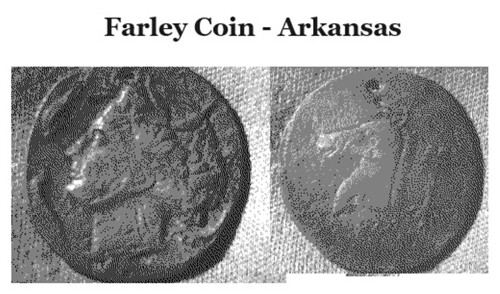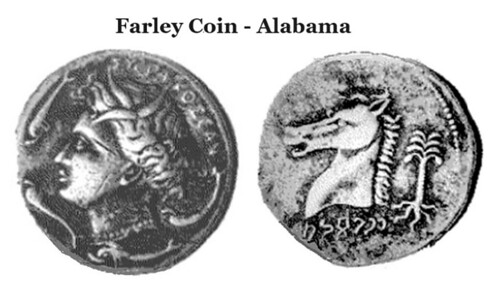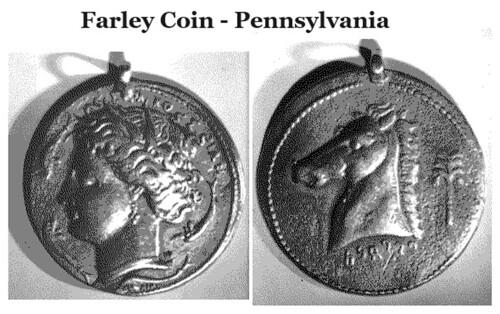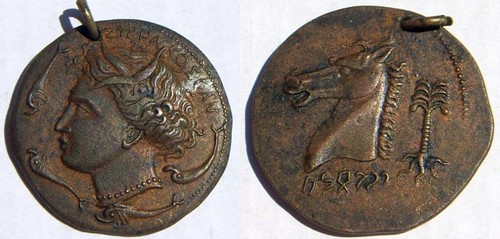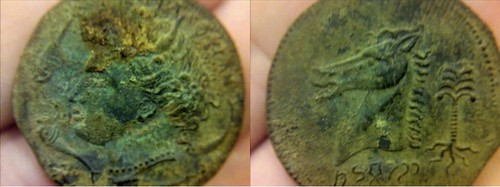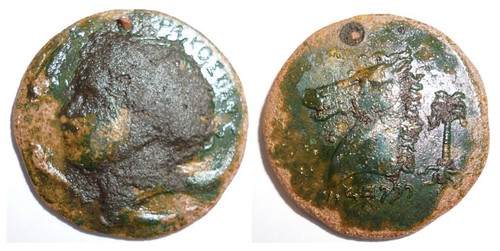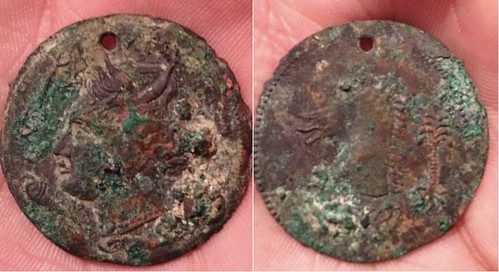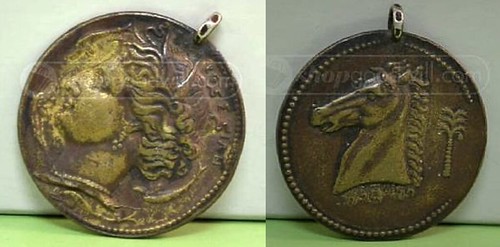
PREV ARTICLE
NEXT ARTICLE
FULL ISSUE
PREV FULL ISSUE
THE FARLEY COINSHere's the second of Pete Smith's three articles on "Epigraphic Explorer" Gloria Farley. This one focuses on the "coins" themselves. -Editor In her 1993 book, In Plain Sight: Old World Records in Ancient America, Gloria Farley wrote about seven similar coins believed to be evidence of ancient visits to America before Columbus. They are named for the states where they were found. Farley Coin: Arkansas
Jessie Ray Kelley found the coin with a metal detector in 1973 in a field near Cauthron, Arkansas, about 19 miles east of Heavenor, Oklahoma. It was sent to Boston for examination by Dr. Norman Totten, He wrote:
Farley Coin: Alabama The coin was found by a small boy in Alabama in 1957. It appears to match the style of the Arkansas coin. It is not holed and the only one of the seven that is not a jewelry piece. Farley Coin: Kansas Eddie Thornton reported finding a coin with a metal detector in 1976 buried six inches deep. It has a hole at the top. It matches the style of the Arkansas coin. Farley Coin: Pennsylvania Mini Frank wrote to Farley about a coin she had worn as a pendant since she was five. This piece was about the size of a quarter and had a palm tree with no roots. She had been given the pendant by a gypsy woman. This is smaller than the previous pieces and a jewelry piece rather than a ground find. Farley Coin: Connecticut Frederick J. Gastonguay of Waterbury, Connecticut, sent a photo to Dr. Totten. He had carried it in his pocket for twenty years after finding it in a field near Waterbury. This matched the style of the Arkansas coin. Farley Coin: Nebraska This coin was reported in 1981 but had been found about 1926. It was found by Delsa Knapp when she was about five years old. She found it at the bottom of a hole her brothers had dug in a cave on a tributary of the North Platte River. There is a hole at the top. Dr. Totten confirmed it was authentic. Farley Coin: Georgia This coin was found in Columbus, Georgia, on February 1, 1986, by John Carroll. It was found across the Chattahoochee River from the Alabama coin. It was found with a metal detector about 13 inches below the surface. The coin is holed for suspension and the palm tree has five roots. Other Farley coins were reported after publication of the original list of seven. There has been discussion of them among metal detecting hobbyists but not among numismatists.
Dr. Mark McMenamin wrote Phoenicians, Fakes and Barry Fell, published in 2000. An abstract of the book stated,
In 2009 Mark McMenamin reported that Farley Coin: Northampton, Massachusetts (McMenamin)
McMenamin inspected this coin in 2000. McMenamin described it as Additional finds are noted by contributors to Treasurenet.com: Farley Coin: Wisconsin (Treasurenet) This coin was reported in 2009 to have been found by Dale Brennan many years earlier while he was metal detecting as a child. Brennan stated it was 29mm and 10 grams. Farley Coin: Connecticut (Treasurenet)
Ugotit22 reported that he found this coin in the yard of an Farley Coin: Maine (Treasurenet)
This specimen was posted by a Treasurenet member as having been included in an Farley Coin: Oregon (Treasurenet)
Farley Coin: Massachusetts (Treasurenet)
In 2014, Tenderfoot reported that he found this specimen Farley Coin: Farley Coin: Goodwill (Treasurenet) This coin was reported to have been bought at auction for $50 in 2013 at a Goodwill in an unknown location. The palm tree has no roots. This coin really does not qualify as a Farley Coin. It is obviously a more modern replica on round stock and was not found in the ground. It is unlikely that the ancient Phoenicians dropped their coin in a Goodwill collection box.
Wayne Homren, Editor The Numismatic Bibliomania Society is a non-profit organization promoting numismatic literature. See our web site at coinbooks.org. To submit items for publication in The E-Sylum, write to the Editor at this address: whomren@gmail.com To subscribe go to: https://my.binhost.com/lists/listinfo/esylum All Rights Reserved. NBS Home Page Contact the NBS webmaster 
|
